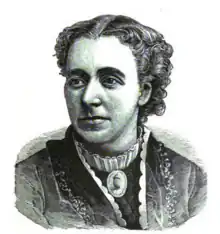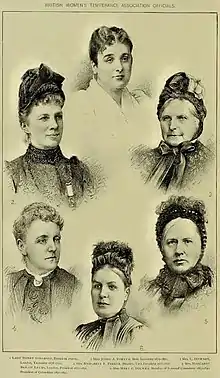

The White Ribbon Association (WRA), previously known as the British Women's Temperance Association (BWTA), is an organization that seeks to educate the public about alcohol, tobacco, and other drugs, as well as gambling.[1]
Founding of British Women's Temperance Association
The British Women's Temperance Association (BWTA) was founded following a meeting in Newcastle upon Tyne in 1876 featuring American temperance activist "Mother" Eliza Stewart. Margaret Eleanor Parker, a founding member, served as its first president.[2] The next president was Clara Lucas Balfour. Margaret Bright Lucas, who toured with Stewart during these meetings, succeeded as BWTA president in 1878. The BWTA achieved greater success under her successor, Lady Henry Somerset, but ultimately British temperance was destined to achieve less than its American counterpart. Lady Henry was succeeded by Rosalind Howard, Countess of Carlisle, known as "The Radical Countess" for her opposition to alcohol consumption. Lucas was however, an important link in the Anglo-American women's reform networks as well as being a pioneer in British women's temperance.

Early years
In 1885, the association was affiliated to the World Woman's Christian Temperance Union (WWCTU), of which body Lucas was the first president. The pledge of the BWTA was, "I promise by God's help to abstain from all intoxicating drinks, and to try to induce others to do the same."[3]
The association's internal organisation consisted of:
- National Executive Committee: National President, Vice President, Secretary and Treasurer as well as representatives from County Unions
- County Unions - to support branches in their areas and establish new ones
- Branches (throughout Great Britain) and from 1879, an autonomous but affiliated BWTA Scottish Christian Union.[4][5]
The departments of the association were: Organization; Speakers' Bureau; "Y" (Young Women's) B. W. T. A. ; Temperance Legions; Evangelistic; Bible Lessons and Study : Unfermented Wine at the Sacrament; Preventive; Social Purity; Social; Drawing-Room Meetings; Facts: Educational; Health and Hygiene; Adult Schools; High Schools and Private Schools; Legal; Brewster Sessions; Police Matrons; Women as Poor Law Guardians; Members of School Boards, etc.; Work Among Women Municipal Voters; Political; Literature and Press; Inebriate Women; Native Races; Traveling.
In the year 1893-94, 1,500 meetings were held by members of the National Executive Committee, and 2,000 in all were reported to headquarters; 300 new societies were formed; 8,500,000 pages of literature were issued, including the organ, The Women's Signal, which had a circulation of 16,271 per week.[3] Temperance clubs worked to provide public drinking fountains, sometimes called a "temperance fountain" which were often placed opposite public houses to provide alternatives to alcohol. In response to a call by Lady Somerset in 1896, the White Ribbon Children's club funded the construction of a fountain with a bronze portrait of a "Cold Water Girl" mounted on a granite base. The fountain is now placed in the Eastern Victoria Gardens near to Victoria Embankment in London.[6] During the World Wars, the branches and county unions set up kitchens, mobile canteens, recreation and refreshment rooms for military personnel.[7]
After a contentious annual meeting in 1893 during which Lady Somerset led the change in club policies to include the support for women's suffrage, the organization split. A new group was formed, the Women's Total Abstinence Union (WTAU), which focused solely on temperance, electing former BWTA officers Lucy Ann Brooks, Docwra, and Martha Holland as WTAU officers.[8] The BWTA was re-named the National British Women’s Temperance Association[9] and its honorary secretary was Jane Aukland.[10]
The Association supports a whiteribbon (publishing) company, an industrial farm home, a retreat for inebriate women, St. Mary's Training Home for Girls Alpha House, a preventive and rescue home. A Scottish Christian Union independent but affiliated to the British Women's Temperance Association was organised in 1876 -9,[3] and had grown to 80,000 members, 332 branches by 1908.[5] One of its members, Eliza Wigham became a vice-president of BWTA.[5] In 1915, Christina Marshall Colville was elected president of the BWTA Scottish Christian Union.[11]
Activities

The BWTA ran many successful and lively girls' groups, known as Y-branches (for youth). These were often associated with Methodist and other non-conformist churches, and organised all kinds of activities as well as weekly meetings. One of their most successful was a "Masque of Noble Women", which was performed by dozens of branches all over Britain from 1915. A box of costumes was bought and lent out to branches along with copies of the script. Probably modelled on the suffragette "Pageant of Great Women", it featured popular heroines including Florence Nightingale, Queen Victoria, Boadicea and Elizabeth Barrett Browning.[12]
After the BWTA became aroused to the fact of the alarming increase of inebriety among women, it studied the subject and, under the leadership of its president, Lady Henry Somerset, started in 1895, the Duxhurst Industrial Farm Colony, a voluntary in-patient residential treatment center for habitual alcoholic women. Situated about 4 miles (6.4 km) from Reigate railway station, the 180 acres (73 ha) "Village" contained home-like cottages, a church, the chaplain's lodge, farm buildings, a hospital, and a large dining and recreation hall.[13][14][15]
In the 1990s a Mobile Education Unit would set up exhibits at festivals or shopping centres to raise awareness about the organization and its goals.[7]
BWTA women often wore white ribbons as a symbol of the Temperance cause, and thus their organ was named the White Ribbon.[16]
A permanent office for the National British Women's Temperance Association (NBWTA) opened in 1923 at 104 Gower Street, London. In 1952 the organisation moved to 23 Dawson Place in London, and in 2006 the headquarters were moved to 341 Tanworth Lane, Solihull.[7]
Transition to White Ribbon Association
In 2004, the organisation was re-named the White Ribbon Association. Today, the White Ribbon Association offers free services and resources focusing on health education and a variety of topics for children's displays. The White Ribbon Association welcomes visitors to the Archives where they have archived many products and records from the 19th and early 20th century.[17]
Notable people
- Jane Aukland
- Clara Lucas Balfour
- Florence Balgarnie
- Frances Julia Barnes
- Emily Rose Bleby
- Mary Shuttleworth Boden
- Jane Gemmill
- Rosalind Howard, Countess of Carlisle
- Mary Camilla Lawson
- Margaret Bright Lucas
- Margaret Eleanor Parker
- Catherine Forrester Paton[18]
- Lady Henry Somerset
- Eliza Wigham
- Agnes Weston
References
- ↑ "About Us". White Ribbon Association. Retrieved 10 January 2021.
- ↑ Blocker, Fahey & Tyrrell 2003, p. 115.
- 1 2 3 Bliss 1898, p. 1419.
- ↑ "Our History". White Ribbon. Retrieved 2021-11-16.
- 1 2 3 Smitley, Megan K. (2002). 'Woman's mission': the temperance and women's suffrage movements in Scotland, c.1870-1914 (PhD). Glasgow: University of Glasgow. p. 38.
- ↑ "Temperance fountains". White Ribbon Association. Retrieved 10 January 2021.
- 1 2 3 "140th Anniversary of the White Ribbon Association (1876 – 2016)". White Ribbon Association. Retrieved 10 January 2021.
- ↑ Blocker, Jack S. (2003). Alcohol and Temperance in Modern History: An International Encyclopedia. ABC-CLIO. p. 686. ISBN 978-1-57607-833-4. Retrieved 22 July 2022.
- ↑ "140 Years of the White Ribbon Association (Part Two)". White Ribbon Association. Retrieved 10 January 2021.
- ↑ Shiman, Lilian Lewis (2004-09-23). "Aukland, Jane Munday (1836–1925), temperance campaigner". Oxford Dictionary of National Biography (online ed.). Oxford University Press. doi:10.1093/ref:odnb/55093. ISBN 978-0-19-861412-8. Retrieved 2023-06-30. (Subscription or UK public library membership required.)
- ↑ Cherrington, Ernest Hurst (1925). Standard Encyclopedia of the Alcohol Problem. Vol. 2. American Issue Publishing Company. p. 660. Retrieved 1 August 2022 – via Internet Archive.
 This article incorporates text from this source, which is in the public domain.
This article incorporates text from this source, which is in the public domain. - ↑ Binns, A (2017). "New Heroines for New Causes: how provincial women promoted a revisionist history through post-suffrage pageants" (PDF). Women's History Review. 27 (2): 221–246. doi:10.1080/09612025.2017.1313806. S2CID 151598490.
- ↑ "DUXHURST FARM COLONY FOR INEBRIATES". British Medical Journal. British Medical Association. 1: 483. 1897. Retrieved 20 August 2022.
 This article incorporates text from this source, which is in the public domain.
This article incorporates text from this source, which is in the public domain. - ↑ Cherrington, Ernest Hurst (1926). Standard Encyclopedia of the Alcohol Problem. Vol. 3. American Issue Publishing Company. p. 868. Retrieved 20 August 2022 – via Internet Archive.
 This article incorporates text from this source, which is in the public domain.
This article incorporates text from this source, which is in the public domain. - ↑ Whitaker, Joseph (1911). "The Industrial Fram Village, Duxhurst, Reigate.". An Almanack... London: Whitaker's Almanack. p. 690. Retrieved 21 August 2022.
 This article incorporates text from this source, which is in the public domain.
This article incorporates text from this source, which is in the public domain. - ↑ "The White Ribbon". Archived from the original on 2017-10-07.
- ↑ "Visit Our Archives". White Ribbon Association. Retrieved 10 January 2021.
- ↑ Lusk, Isabel (2004). "Paton, Catherine Forrester- (1855–1914), philanthropist and a founder of women's missionary training in Scotland". Oxford Dictionary of National Biography (online ed.). Oxford University Press. doi:10.1093/ref:odnb/70062. Retrieved 2019-11-01. (Subscription or UK public library membership required.)
Attribution
 This article incorporates text from this source, which is in the public domain: Bliss, William Dwight Porter (1898). The encyclopedia of social reform: including political economy, political science, sociology and statistics (Public domain ed.). Funk & Wagnalls company.
This article incorporates text from this source, which is in the public domain: Bliss, William Dwight Porter (1898). The encyclopedia of social reform: including political economy, political science, sociology and statistics (Public domain ed.). Funk & Wagnalls company.
Bibliography
- Blocker, Jack S.; Fahey, David M.; Tyrrell, Ian R. (2003). Alcohol and Temperance in Modern History: An International Encyclopedia. ABC-CLIO. ISBN 978-1-57607-833-4.
- Winskill, P.T. (1892). The Temperance Movement and Its Workers. A Record of Social, Moral, Religious, and Political Progress. Vol. III (PDF). London: Blackie & Son, Ltd. Retrieved 10 January 2021.
- Oxford Dictionary of National Biography